were almost identical cameras.


A very remarkable camera loved by professional photographers.
The Graflex Super D was
the successor of the Graflex
Series D which was used by the famous Dorothea Lang during the depression era.
The Super D
has a focal plane shutter as well as a front shutter just like its
predecessor.
However there were some new features such as the flash connector and
the
revolving back.
It had a synchronisation for "open flash". The camera
had a new front section and a larger focusing hood.
The Super D was
equipped
with a shutter mechanism that made it possible to use the new semi
automatic
pre-set stop diaphragm
which working is explained her below.
The semi automatic
diaphragm
of the Super D enabled the photograph to focus the subject with open
diaphragm.
When firing, the release lever activates the pre selected
diaphragm setting just before the mirror is rising.
When the mirror is
up, the curtain with the slit will pass along the film surface to
expose.
The diaphragm has to be manually re-cocked before each
exposure.
The automatic diaphragm was invented and
patented by
a Chicago photographer Torkel Korlin (1903-1998).
However the
Super D sales did not came up to expectations, reason why Korling
decided not to renewal the patent.
Shortly after
this sadly decision the automatic diaphragm became very popular with
the 35 mm cameras.
The main reason to
choose for such a camera was
the fact that large format hand held photography was possible while
watching the
subject.
High speed photography as well as portrait.
The
revolving back
enables landscape as well as portrait mode just by turning the
revolving back
including the film holder or film pack.
These cameras accept the
slotted-type Graflex holders: there is a groove down each side of these
holders, and sliding bars fasten them to the rear of the camera.
NOTE:
These Super D nor Series D cameras do NOT accept modern 4x5 holders, which are slightly
different in size, and beside that they lack the grooves.


The Graflex Super
D was equipped with the ƒ:
5,6 Kodak 190 mm Lens.
The large lens board permitted the use of lenses
as fast
as 2,9.
A large range of lenses was available including a large barrel
lens.
Graflex Series D was used by Dorothea Lang during the Depression era.

Dorothea Lang February 1936. ( added information by Bruce Thomas.)
"The camera is an instrument that teaches people how to see without a camera."
Dorothea Lang - Photographer
Graflex Cameras,
such as the Graflex Junior and the Revolving Back
Series B are basically the same and are operated in the same way
.
Principle features were the collapsible self erecting focusing hood,
the reflecting mirror, the focal plane shutter and the revolving back.
All packed together in a neat cube
housing covered with black leather.
The camera was
build around a mirror which reflects the image formed by the lens on
the ground glass.
The image appears straight up on the ground glass which makes it possible to
judge the sharpness and depth of field.
The
mirror is made to swing upwards for exposure.
At the same time the
focal plane shutter starts to travel
across the film surface to produce the exposure.
This is the
basic principle of the operation of each Graflex reflex camera model.

The 3 1/4 x 4 1/4 was manufactured from 1941 - 1963.
Note the flash bi post mounted on the upper panel right below the winding key and the flash bracket near the front side.
The 4 x 5 inch Super D was manufactured from 1948 up till 1958 basically equipped with the semi automatic diaphragm 152 mm Kodak Ektar lens or the Kodak Ektar 190 mm - f=5,6. It was an updated Series D camera with chrome trim and a synchronized outlet for the focal plane shutter open flash method. The newer versions were equipped with a reliable flash contact for use with the focal plane shutter. The improved shutter would permit high speed synchronization with long peak bulbs, such as the #31 and Sylvania 2 A bulbs at 1/200= 1/400 and 1/1000.
| feet | meter | 1/200-1/250 | 1/400-1/500 | 1/1000 |
| 6 | 1,80 | f=32 | f=22 | f=16 |
| 10 | 3,00 | f=16 | f=11 | f=8 |
| 15 | 4,50 | f=11 | f=8 | f=5,6 |
| 20 | 6,00 | f=8 | f=5,6 | f=4,5 |
While winding the curtain by the winding key, disconnect the cable connecting the flash with the camera to prevent pre firing of the bulb as the curtain is packed.
The 34" Super D
with 152 mm f=4,5 Ektar in semi automatic diaphragm was like the 45"
especially designed for the professional photographer.
The
interchangeable
lens board
made it possible to use different lenses such as the 10 inch 5,6
Tele Optar, which was very popular with the portraitists.
Based on a 1912
concept, the Super D Graflex was until the sixties a very usable camera
for portraits.
However the lack of tilt and shift made it unsuitable for
architectural work.
Despite the fact that it was not a typical press
camera, because one has to focus
with the head down looking on the ground glass rather than keeping an
eye on the scene in front,
Dorothea Lang took the finest photos with
this type of camera.
Earlier the
predecessors of the Super D camera were also present with the Byrd
Expedition to the South Pole.
Photo
on the right side is a Graflex 5 x 7 Series B with a stationary
back.


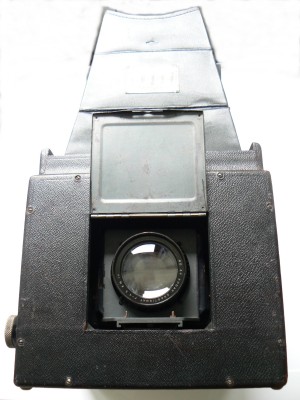
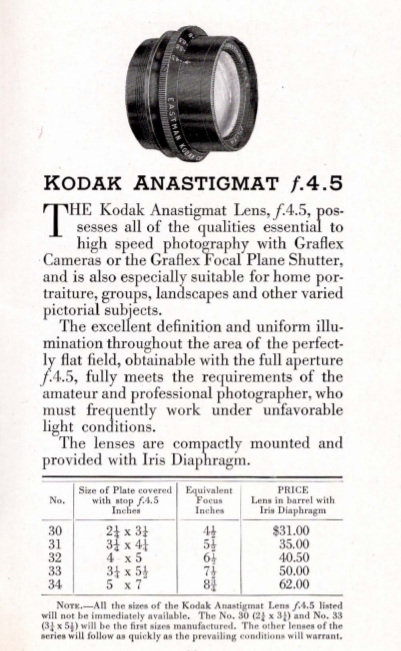
The semi automatic
diaphragm
of the Super D enabled the photograph to focus the subject with open
diaphragm.
When firing, the release lever activates the pre selected
diaphragm setting just before the mirror is rising.
When the mirror is
up, the curtain with the slit will pass along the film surface to
expose.
The diaphragm has to be manually re-cocked before each
exposure. The automatic diaphragm was invented and
patented by a Chicago photographer of children Torkel Korlin
(1903-1998).
However the
Super D sales did not came up to expectations, reason why Korling
decided not to renewal the patent.

Patented by Torkel Korling January 28,
1936.
The next text is the explanation of the working of the automatic diaphragm.
It is well known to the users of single-lens reflex cameras that it would be a decided advantage to focus with the diaphragm wide open, thereby having available a greater quantity of light on the ground glass than would be had if the diaphragm were stopped down to that aperture at which the picture was to be made. Assuming, for example, that the operator is desirous of making an exposure at f11, as a rule, insufficient light would reach the ground glass focusing screen to focus the camera, accurately. However, if the diaphragm were open, say to f4.5, adequate light would be had. But in making these changes manually, the operator often forgets or does not have the time to adjust the diaphragm to its proper setting after focusing. I herein disclose automatic means for doing this, providing means whereby the diaphragm of the lens is set at the full open position and a pre selected stop is chosen and adjustment made accordingly. At the instant of making the exposure, the diaphragm operating mechanism is released automatically, closing down the diaphragm to that pre-selected opening without any thought on the part of the operator.
Shortly after his sadly decision not to renewal his invention, the automatic diaphragm was patented by Oscar Steiner in 1940.
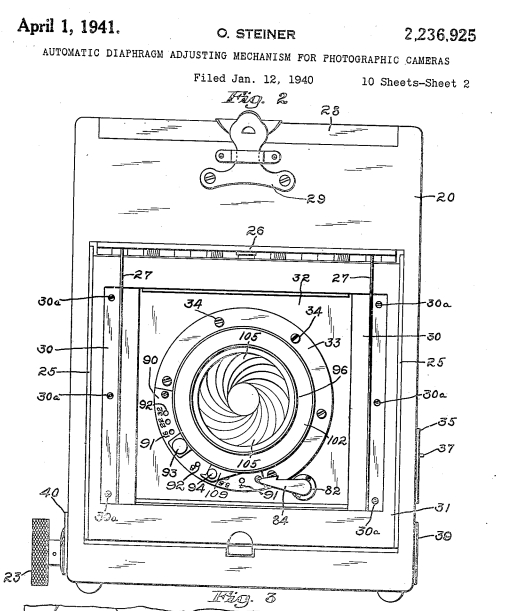
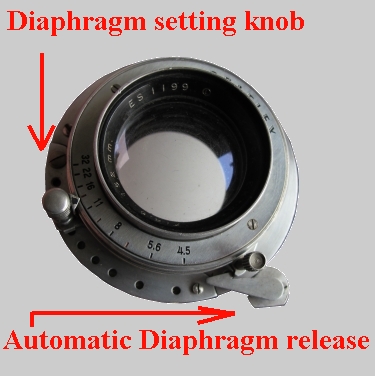
Above the Graflex Automatic Diaphragm Shutter in
action.
The diaphragm has been pre-set on 16 while the diaphragm is still wide open
providing a greater quantity of light on the ground glass.
The camera shutter release knob is connected to the arm on the right side of the
shutter and keeps the diaphragm open until the camera exposure knob will be
operated and released.
The spring will pull the diaphragm in the desired position.
AUTOMATIC DIAPHRAGM ADJUSTING MECHANISM FOR PHOTOGRAPHIC CAMERAS.
The automatic diaphragm was one of the accessories that made this camera so special. Because of its old fashion design and using old techniques together with new developments, the Graflex Super D was loved by the professional photographer up to the late sixties, but also by the today's camera collector and even more by the user of classic cameras. It's quite a nice usable camera and it offers the use of some interesting lenses. A very important feature of this invention is that all the mechanism directly connected or related to the automatic diaphragm control mechanism is mounted on the lens board which can be removed from the camera without in any way disarranging other controls of the camera. These lens boards are removed by pushing lens and lens board straight up against a build in hidden spring, until the lens board is free.
The Super D is equipped with the 5 slit focal plane shutter. Unlike its predecessors, the Super D has only 2 spring tensions L and H speed selections, ranged from 1/30 to 1/1000. From 1948 on, the camera was refined to include a choice of two Ektar lenses and an Ektalite field lens under the ground glass. The advantage of using barrel lenses is one of the successes of this classic camera. However, you wont get infinity focus with a shorter lens than the 190 mm because of the construction of the camera. The bellows when fully cranked back, has to clear the reflex mirror. About 152 mm (3x4 camera) and 190 mm (4x5" camera) was the minimum focus distance that could be accommodated. Another advantage of the most up to date Graflex Super D was the build in flash synchronization. The circuit of the build in "open flash" synchronizing feature is closed by a silver spring contact on the mirror and the other on the release lever. As the release lever is depressed the mirror rises and the electric circuit is closed, igniting the bulb just before the curtain begins to close, thus giving a open flash exposure, the duration of which is determined by the flash lamp employed.
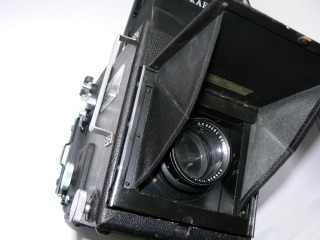
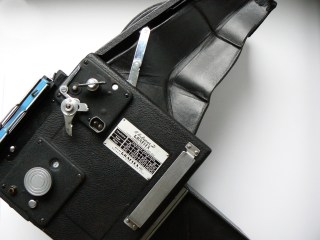
The Post War Super
D can easily be identified by its
chrome ID tag above the lens and the simplified shutter-speed plate
with the
sync outlet.
The improved shutter would permit high speed
synchronization with Sylvania
2A PF long peak bulb at 1/200 - 1/400 and 1/1000
second.
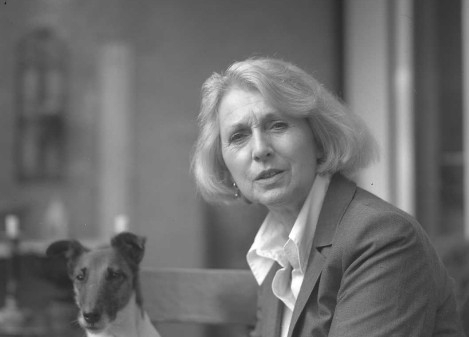
Graflex Super D - 4 x 5 inch
Automatic diaphragm Kodak Ektar190 mm f=5,6 1/125 sec.
ILFORD - FP4 PLUS 125
The Graflex Super D equiped with the 8 inch Pentac lens.
Back to Graflex Cameras Home Jo Lommen Classic Press Cameras